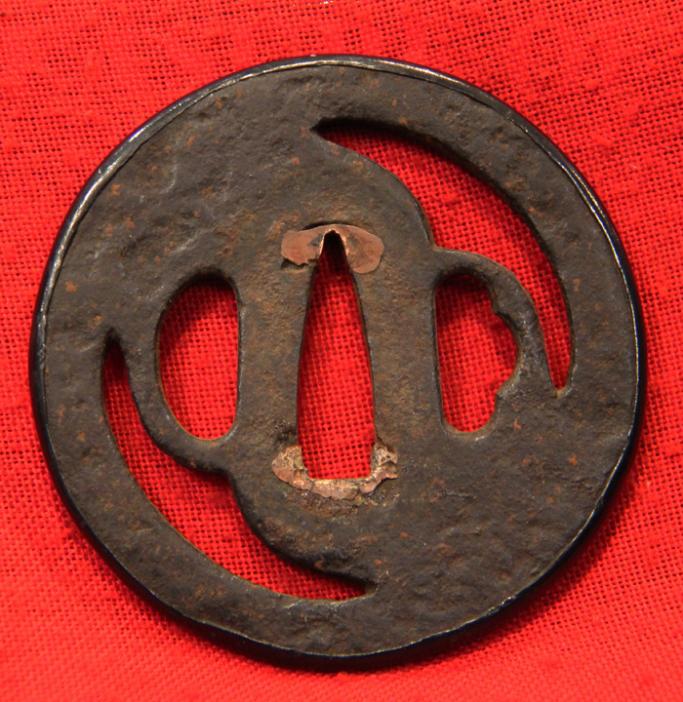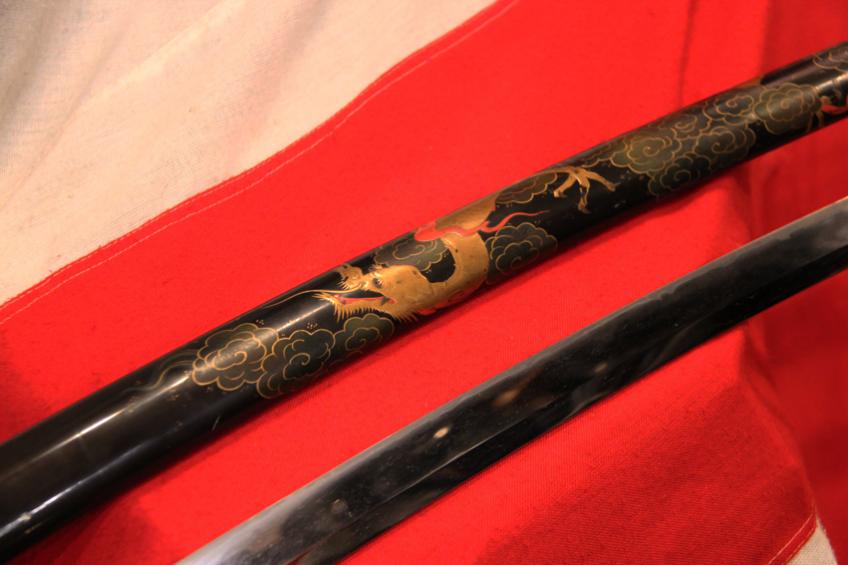Beautiful Nagamaki Katana of the Hojo Clan, Signed Hishu Ju Kanehisa, Koto Period with Hidden Secret Compartment Fushi
A most beautiful Koto period sword, nagamaki naoshi form and style, made around 1450 to 1500. The nagamaki naoshi were originally very long polearm blades reformed into katana or wakazashi, however the style was immensely popular and thus original katana blades were made to reflect and copy this style of blade from the old adapted pole arm blades from previous centuries. Very fine lacquer saya of the Hojo family dragon in clouds. The fushi of patinated copper fully decorated with nanako bears the triple triangle clan mon, in multiples, of the Hojo clan, it also bears within it a concealed inner liner than could be used to hide small documents or secret communications. Koto iron sukashi tsuba with shakudo mimi rim. Gold covered habaki, carved buffalo horn kashira and dragon menuki. The legend of the origin of the Hojo mon says that Tokimasa Hojo (1138-1215) came into a cave on Enoshima, an island south of modern Tokyo where he prayed that his descendants would be prosperous. The dragon god who dwelt in that cave granted him his wish, leaving behind 3 of his scales. These are the scales that are represented in the three triangles of the “Triforce” of the Hojo. Hojo Soun was the first head of the Late Hojo clan 1493-1590 one of the major powers in Japan's Sengoku period. Born Ise Moritoki, he was originally known as Ise Shinkuro, a samurai of Taira lineage from a reputable family of Shogunate officials. Although he only belonged to a side branch of the main, more prestigious Ise family, he fought his way up, gaining territory and changing his name in imitation of the illustrious Hojo.
Traditionally Soun held a reputation of a ronin who rose to power almost overnight in Kanto; however, he belonged to a prestigious family in the direct employment of the Ashikaga shoguns, and enjoyed important family connections. His sister was married to Imagawa Yoshitada, a major daimyo from a prestigious cadet branch of the Ashikaga family. Shinkuro became a retainer in the Imagawa clan, and when Yoshitada died in battle in 1476, Shinkuro mediated the succession dispute between supporters of Yoshitada's son Imagawa Ujichika and Yoshitada's cousin, Oshika Norimitsu. This proved a temporary peace. When Norimitsu again attempted to gain control of the Imagawa clan, S?un came to Ujichika's defense, killing Norimitsu. Soun was rewarded by Ujichika with Kokukuji castle. He gained control of Izu Province in 1493, avenging a wrong committed by a member of the Ashikaga family which held the shogunate. With S?un's successful invasion in Izu province, he is credited by most historians as being the first "Sengoku Daimyo".
About 1475, under the cognomen of Ise Shinkuro, he worked for Imagawa, the constable of Suruga Province, and eventually became an "independent leader" with a number of warriors joining him. In 1491, he was able to take Horigoye after the death of Kanto Kubo Ashikaga Masatomo died, gaining control of Izu Province. He then adopted the surname of Hojo and the given name of Soun or Sozui. After building a stronghold at Nirayama, Hojo Soun secured Odawara Castle in 1494, the castle which would become the center of the Hojo family's domains for nearly a century. In an act of treachery, he seized the castle after arranging for its lord to be murdered while out hunting. In 1516, he laid siege to the castle of Arai, and "was virtual master of all Sagami."
Soun died the following year, and passed on the newly built Hojo domains to his son Ujitsuna, who subsequently changed the clan name from the original Ise to Hojo and posthumously renamed his father to Hojo Soun. In 1521, Ujitsuna built Soun-ji temple dedicated to his father. The third siege of Odawara occurred in 1590, and was the primary action in Toyotomi Hideyoshi's campaign to eliminate the Hojo clan as a threat to his power. The months leading up to it saw hasty but major improvements in the defense of the castle, as Hideyoshi's intentions became clear. The massive army of Toyotomi Hideyoshi surrounded the castle in what has been called "the most unconventional siege lines in samurai history." The defenders slept on the ramparts with their arquebuses and armour; despite their smaller numbers, they discouraged Hideyoshi from attacking. After three months, the Hojo surrendered, facing overwhelming numbers and, presumably, an impending shortage of food and supplies. Tokugawa Ieyasu, one of Hideyoshi's top generals, was given the Hojo lands. Though Hideyoshi could not have guessed it at the time, this would turn out to be a great stepping-stone towards Tokugawa's attempts at conquest and the office of Shogun. Overall37 inches long in saya, blade 26.5 inches long tsuba to tip.
Code: 23783
Price
on
Request










